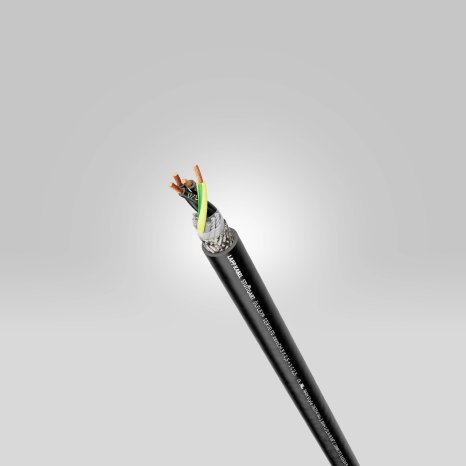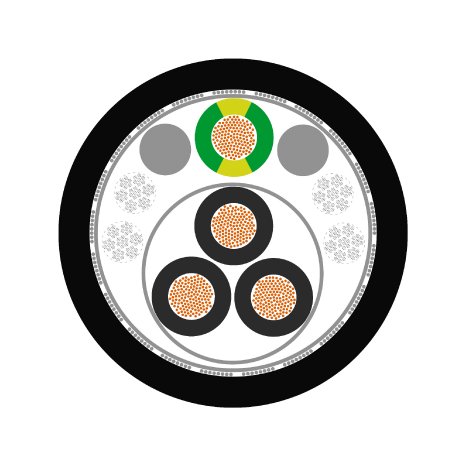Especially in industrial plants where frequency-converter-controlled motors are used, there is an increase in undesirable currents on the potential equalisation cables or protective earth cables. LAPP therefore set itself the goal of investigating the physical coupling mechanisms within motor connection cables and deriving an innovative cable design from this.
New cable design
In developing the zeroCM® technology, LAPP took completely new paths. Instead of solving the EMC problem via shielding as usual, the entire cable design of the ÖLFLEX® SERVO FD zeroCM has been rethought. Three phase conductors are now arranged symmetrically and twisted in an inner layer. Additionally, at least one protective conduit is stranded in an outer layer with the opposite stranding bending direction around the three phase conductors in a specific lay length ratio. The insulation of the conductor is capacitance-optimised and consists of polyethylene, polypropylene or a foam variant. Between the inner layer and the outer layer is a separating fleece. “This special, innovative stranding technique achieves perfect electrical symmetry, which reduces magnetic radiation and considerably reduces internal couplings”, explains Stefan Hilsenbeck, Senior Engineer Advanced Technology at Lapp Holding AG.
The benefits of the invention are obvious. The EMC-optimised cable design is easy to implement and offers the best protection against EMC-related interference currents. "The cable is asymmetrical in its visual appearance, but we achieve 100% electromagnetic symmetry, thereby even resulting in a cable with less shielding", emphasises Hilsenbeck.
In summary, while zeroCM® technology does not eliminate the cause of EMC interference, it precisely addresses one of the key points where interference is introduced into the system environment. On the one hand, the innovative cable design enables compensating currents to be reduced by up to 80% at the frequency converter output and on parallel paths such as data cables. On the other hand, reduced cable charging currents reduce the load on and in the frequency converter itself: for example, longer cable lengths can be installed without the frequency converter being operated outside its (EMC) specification. The zeroCM® technology also prevents the generation of voltage levels on the ground voltage on the consumer side. This is particularly important when sensitive sensors such as analogue transducers are used, for example.
“PEPA” research project
The effectiveness of the innovative cable was confirmed as part of the “PEPA” research project run by the German Federal Ministry for Economic Affairs and Climate Protection. In addition to LAPP, the companies SEW-EURODRIVE, BLOCK, Danfoss, MAGNETEC and the Technical University of Darmstadt are involved in the project. The best values in terms of leakage current at the converter output were achieved by the low-capacitance design of the zeroCM cable. The interference current flowing via a parallel signal cable was also investigated. Here, too, the use of the zeroCM® cable leads to the development of the lowest possible interference currents.
Lower costs
In addition to the benefits described, customers can also save on costs, as complex filter technology is no longer necessary, and the system is more stable. "Although the new cable may seem unusual when it is first assembled, the cabling remains as simple as always, and the required work is even reduced compared to earth-symmetrical cables with three-part protective conduits, which are still common on the market", says Hilsenbeck.
LAPP wants to further expand its portfolio with zeroCM® technology. Next, the focus will be on hybrid cables. In addition to the power cores, hybrid cables, buses or one-cable solutions also include data, resolver or control core pairs, which have previously been extensively shielded from the power cores. The zeroCM® technology gives us completely new freedom in arranging the design elements, which will reduce material use and increase performance.LAPP's new and patented zeroCM® cable technology has received trademark registration in Switzerland.



